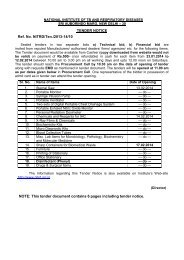The Indian Journal of Tuberculosis - LRS Institute of Tuberculosis ...
The Indian Journal of Tuberculosis - LRS Institute of Tuberculosis ...
The Indian Journal of Tuberculosis - LRS Institute of Tuberculosis ...
You also want an ePaper? Increase the reach of your titles
YUMPU automatically turns print PDFs into web optimized ePapers that Google loves.
Original Article Ind. J. Tub., 1992, 39, 9<br />
SHORT COURSE CHEMOTHERAPY AND EFFICIENCY VARIABLES IN<br />
NATIONAL TUBERCULOSIS PROGRAMME : A MODEL<br />
A.K. Chakraborty 1 , V.H. Balasangameshwara 2 , P. Jagota 3 , T.R. Sreenivas 4 , and K. Chaudhuri 5<br />
(Original received on 19.2.91; Revised version received on 4.9.91; Accepted on 8.11.91)<br />
Summary. <strong>The</strong> mathematical model presented here<br />
brings out the role <strong>of</strong> various levels <strong>of</strong> efficiency in<br />
the performance <strong>of</strong> key tuberculosis control<br />
activities in the light <strong>of</strong> the introduction <strong>of</strong> short<br />
course chemotherapy (SGG) under the District<br />
Tuberculsosis Programme (DTP) in India. It shows<br />
that the potential <strong>of</strong> DTP could be realised only<br />
when all the Various activities are performed with<br />
a high degree <strong>of</strong> efficiency; And that SCC alone<br />
cannot appreciably alter the DTP Efficiency<br />
expectations. For example, DTP efficiency with<br />
SCC, even when 100% <strong>of</strong> patients take more than<br />
80% <strong>of</strong> the prescribed drugs increases only to 29%<br />
with SCC, over 24% with standard chemotherapy<br />
(SR), if case-finding efficiency (CF efficiency)<br />
remains unchanged at 33%, Which is its current<br />
level. A “critical DTP efficiency” i.e., the efficiency <strong>of</strong><br />
the various DTP activities that could lead to<br />
sputum conversion <strong>of</strong> 85% <strong>of</strong> the cases diagnosed<br />
requires the performance <strong>of</strong> key activities at a<br />
high level namely, CF efficiency <strong>of</strong> 100%, cases put<br />
on SCC 100% a rid the compliance structure <strong>of</strong> 70%<br />
iii level four and 20% in level three. Thus, DTP<br />
shall have to be geared to meet high performance<br />
requirements to achieve its avowed objectives.<br />
<strong>The</strong> model gives various levels <strong>of</strong> expectations<br />
as the outcome <strong>of</strong> DTP, relating to changes in<br />
efficiency estimates <strong>of</strong> the key DTP activities.<br />
Introduction<br />
<strong>The</strong> introduction in District <strong>Tuberculosis</strong><br />
Programme (DTP) <strong>of</strong> short course chemotherapy<br />
regimens (SCC) which have achieved nearly one<br />
hundred percent treatment efficacy in clinical<br />
trials has generated a high degree <strong>of</strong> expectation<br />
among the planners and programme <strong>of</strong>ficers<br />
regarding the role <strong>of</strong> SCC in tuberculosis control.<br />
<strong>The</strong> faith in SCC as a tool <strong>of</strong> tuberculosis control.<br />
however, needs to be viewed in the light <strong>of</strong> the<br />
earlier hypothesis in respect <strong>of</strong> standard regimens<br />
(SR) 1,2,3. Thus, in a misplaced perception <strong>of</strong><br />
priorities, one may overlook the earlier inference<br />
that was derived from the then mathematical<br />
projection, showing that the overall success in<br />
DTP depended more on increasing the efficiency<br />
<strong>of</strong> case-finding than that <strong>of</strong> treatment, per se.<br />
It may be argued, that mathematical<br />
projection <strong>of</strong> some likely situations (effectvariables)<br />
on the basis <strong>of</strong> some data on the<br />
simultaneous interaction <strong>of</strong> multiple variables<br />
may, after all, lead to a thin approximation to the<br />
actual situations because the quantification <strong>of</strong><br />
interactions is obtained from separate studies.<br />
Moreover, many variables <strong>of</strong> unknown magnitude<br />
may be left out on account <strong>of</strong> failure to conceive<br />
them theoretically and prepare a suitable<br />
hypothesis. Further, confidence intervals <strong>of</strong> the<br />
effect-variables are difficult to work out,<br />
rendering the task <strong>of</strong> calculating a curve <strong>of</strong><br />
mathematical fit a distinct hazard 4 - <strong>The</strong>re is no<br />
denying the difficulty in the case <strong>of</strong> chronic<br />
illnesses in obtaining inferences from<br />
observational studies with multiple cross<br />
classifications. It is also realised that this becomes<br />
almost impracticable in the face <strong>of</strong> increasing<br />
number <strong>of</strong> variables. However, mathematical<br />
models may be helpful, in this context, in getting<br />
a torrent <strong>of</strong> data arranged and processed<br />
systematically 5 ’ even though the indiscriminate<br />
inclusion <strong>of</strong> multiple variables may become<br />
complex and create problems about the<br />
credibility <strong>of</strong> the inferences. Many scientists,<br />
engaged in the study <strong>of</strong> the so called “s<strong>of</strong>t<br />
sciences”, including medical sciences like to<br />
construct models, if only to serve as qualitative<br />
1. Additional Director; 2. Bacteriologist; 3. Chief Medical Officer; 4. Statistician; 5. Director, National<br />
<strong>Tuberculosis</strong> <strong>Institute</strong>, 8, Bellary Road, Bangalore-560 003.<br />
Correspondence : <strong>The</strong> Director, National <strong>Tuberculosis</strong> <strong>Institute</strong>, 8, Bellary Road, Bangalore-560 003..

















